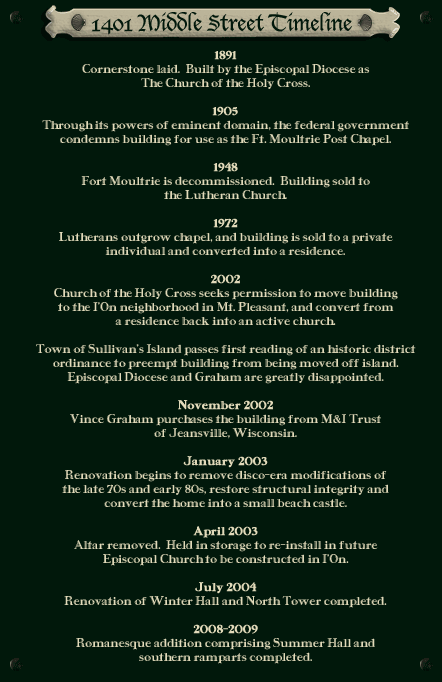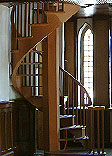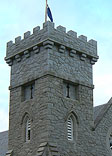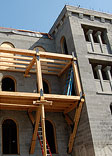84 years later, on November 6th, 1860, Abraham Lincoln was elected President with 39% of the popular vote. Six weeks afterwards, South Carolina dissolved its ties with the Union. Six days later, on December 26th, Major Robert Anderson, together with 70 soldiers, evacuated Fort Moultrie and occupied Fort Sumter. Four months of negotiations ensued in which Confederate General P.G.T. Beauregard requested Major Anderson and his troops relinquish Fort Sumter. Meanwhile, Alabama, Florida, Georgia, Louisiana, Mississippi, and Texas seceded from the Union. With South Carolina, they formed the Confederate States of America on February 8th, 1861.
Lincoln took office on March 4th, 1861. After several weeks of intelligence gathering and debate with cabinet members, the President hatched a plot to provoke the Confederacy to fire upon Fort Sumter and thus provide political cover for his military invasion of the south. Union ships were sent to resupply Fort Sumter. As they approached Charleston, Anderson refused a final request to withdraw from the Fort. Confederate soldiers stationed at Fort Moultrie and other batteries around the harbor opened fire on April 12th. Fortunately, no one was harmed in the Battle, and Major Anderson and his garrison were evicted on April 14th, 1861. The next day Lincoln issued a call for 75,000 troops from the states remaining in the Union.

Until that point, Arkansas, North Carolina, Tennessee, and Virginia, had been unwilling to secede. However, dismayed by the Presidentís actions and
uncomfortable with the untenable idea of compulsory union, they voted to break with the United States and join the Confederate States of America.
On May 27th, the U.S. Army invaded Virginia. The War to Prevent Southern Independence (aka ďThe Civil WarĒ) had begun.
Another 30 years would pass before ground was broken on what is now the Winter Hall of Mugdock Castle. The building was originally constructed as the Chapel of the Holy Cross. It replaced Grace Church, consecrated in 1819, but destroyed in 1863 during the Unionís 545-day bombardment of Sullivanís Island and Charleston.
The first church service was held on July 10th, 1892. On September 12th, 1895, Ellison Capers, the seventh Bishop of South Carolina, wrote in his journal: "Consecrated this day to the worship of Almighty God a beautiful stone edifice erected on Sullivan's Island to be known as "The Chapel of the Holy Cross."
In a jingoistic fervor following its war with Spain in 1898, the federal government began enlarging Fort Moultrie. Covetous of the chapel, the imperial Army moved against Holy Cross. Ignoring pleas of the Episcopal Diocese, the Chapel was forcibly taken on August 10, 1905, allowing a paltry sum of $6,000 ($145,000 in 2010 dollars) as compensation. Down, but not out, a new Church of the Holy Cross was built two miles east. The original building served as the Post Chapel until Fort Moultrie was deactivated in 1947. St. Mark's Lutheran Church then acquired the building for its use. The chapel was deconsecrated in 1972 and converted to a private home.
In 2002, Vince Graham contracted to purchase the property. He planned to move the building to I'On, a neighborhood in Mount Pleasant, and restore it as an Episcopal church. The Sullivanís Island Council took steps to block the move and Graham began preparing legal action. However, his priest at Holy Cross, fearing political repercussions might disrupt construction of a new sanctuary, persuaded Vince to stand down. Captivated by the structure, he nevertheless purchased the sacred ground in November, 2002.
Mindful of its strategic location and the history of foreign and domestic aggression in the area, Graham worked to restore and fortify the building as Mugdock Castle - named for a Graham stronghold built in the 14th century north of Glasgow, Scotland. A Romanesque addition was added in 2009. As the most significant fortification of Clan Graham west of Scotland, Mugdock now serves as a testament to perseverance and a bastion of peace and hospitality.
Another 30 years would pass before ground was broken on what is now the Winter Hall of Mugdock Castle. The building was originally constructed as the Chapel of the Holy Cross. It replaced Grace Church, consecrated in 1819, but destroyed in 1863 during the Unionís 545-day bombardment of Sullivanís Island and Charleston.
The first church service was held on July 10th, 1892. On September 12th, 1895, Ellison Capers, the seventh Bishop of South Carolina, wrote in his journal: "Consecrated this day to the worship of Almighty God a beautiful stone edifice erected on Sullivan's Island to be known as "The Chapel of the Holy Cross."
In a jingoistic fervor following its war with Spain in 1898, the federal government began enlarging Fort Moultrie. Covetous of the chapel, the imperial Army moved against Holy Cross. Ignoring pleas of the Episcopal Diocese, the Chapel was forcibly taken on August 10, 1905, allowing a paltry sum of $6,000 ($145,000 in 2010 dollars) as compensation. Down, but not out, a new Church of the Holy Cross was built two miles east. The original building served as the Post Chapel until Fort Moultrie was deactivated in 1947. St. Mark's Lutheran Church then acquired the building for its use. The chapel was deconsecrated in 1972 and converted to a private home.
In 2002, Vince Graham contracted to purchase the property. He planned to move the building to I'On, a neighborhood in Mount Pleasant, and restore it as an Episcopal church. The Sullivanís Island Council took steps to block the move and Graham began preparing legal action. However, his priest at Holy Cross, fearing political repercussions might disrupt construction of a new sanctuary, persuaded Vince to stand down. Captivated by the structure, he nevertheless purchased the sacred ground in November, 2002.
Mindful of its strategic location and the history of foreign and domestic aggression in the area, Graham worked to restore and fortify the building as Mugdock Castle - named for a Graham stronghold built in the 14th century north of Glasgow, Scotland. A Romanesque addition was added in 2009. As the most significant fortification of Clan Graham west of Scotland, Mugdock now serves as a testament to perseverance and a bastion of peace and hospitality.






